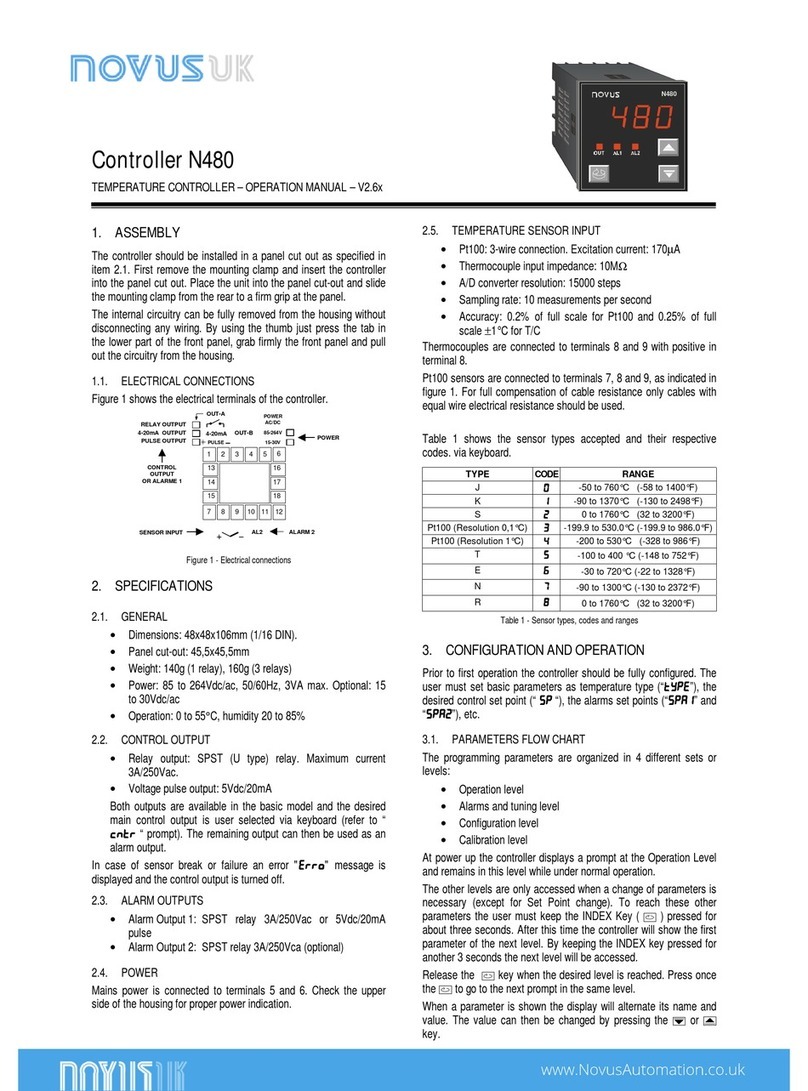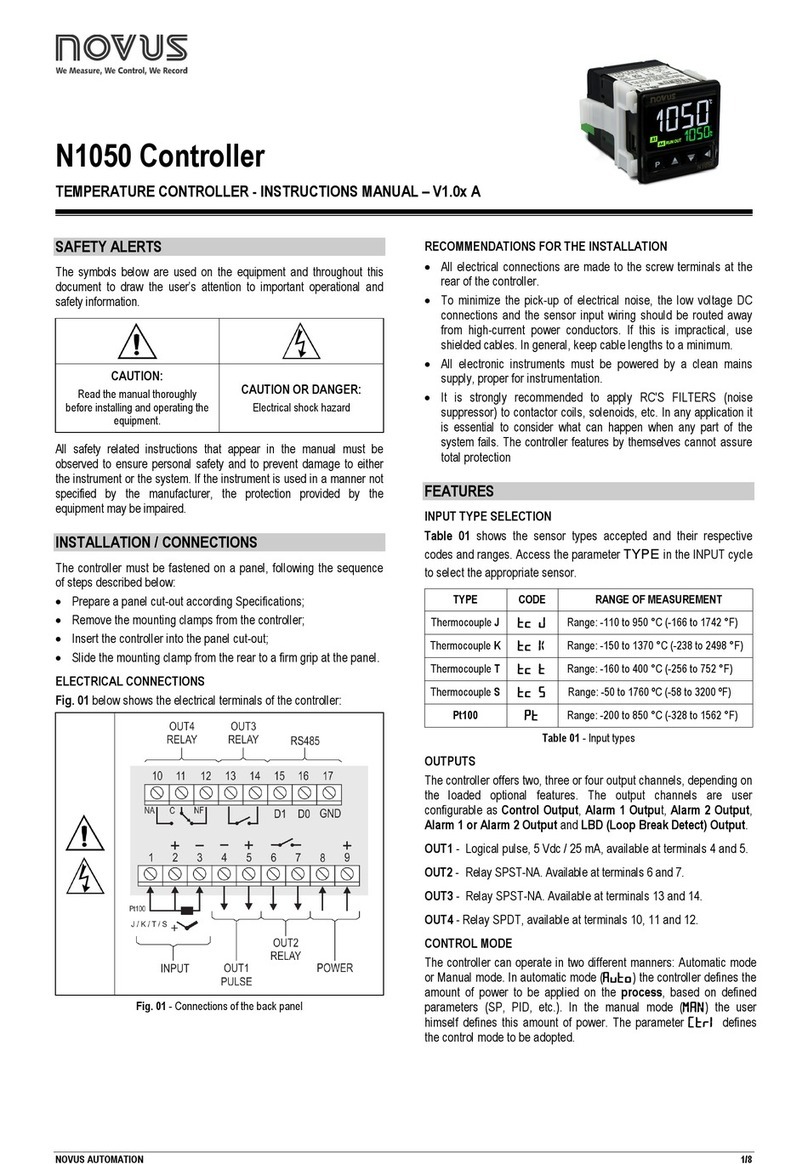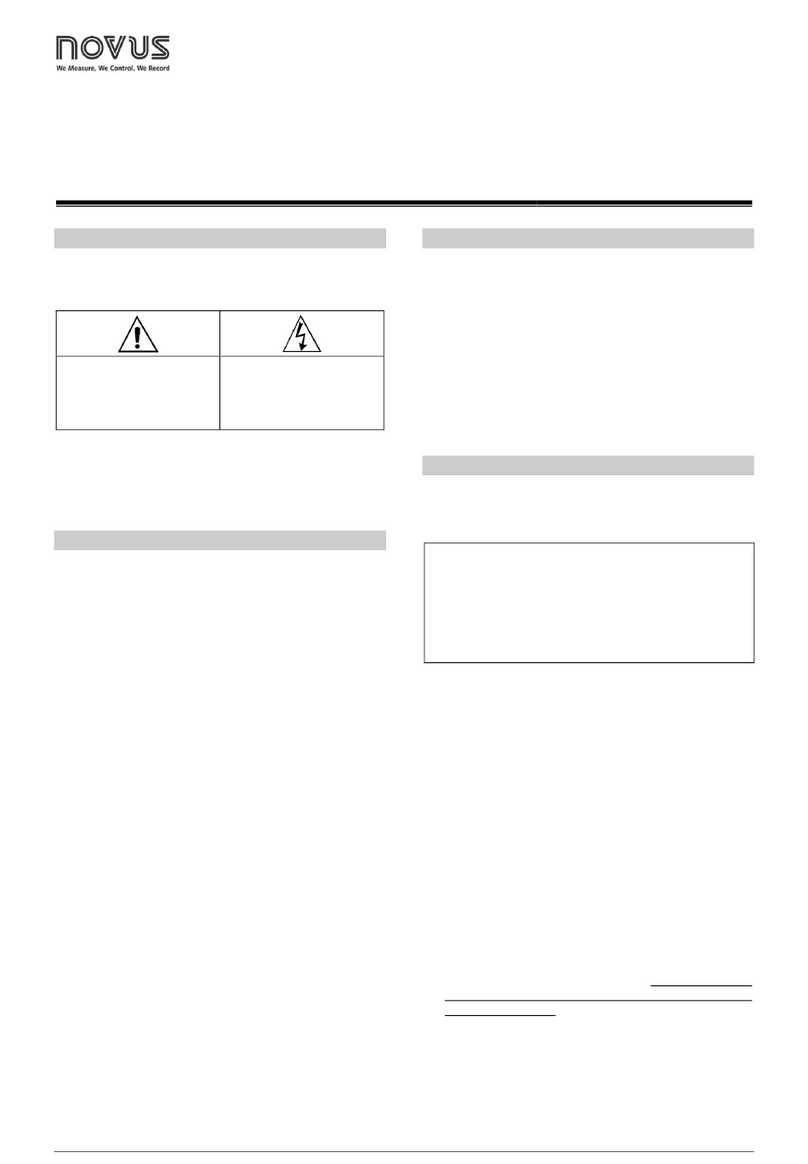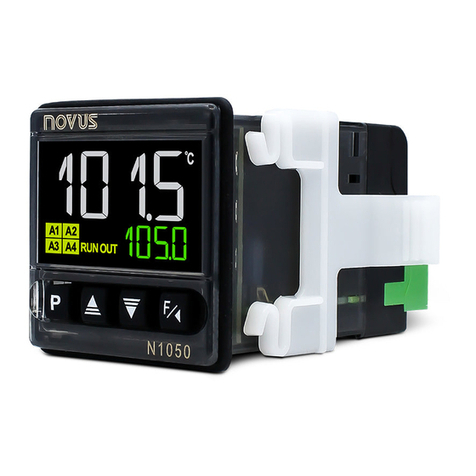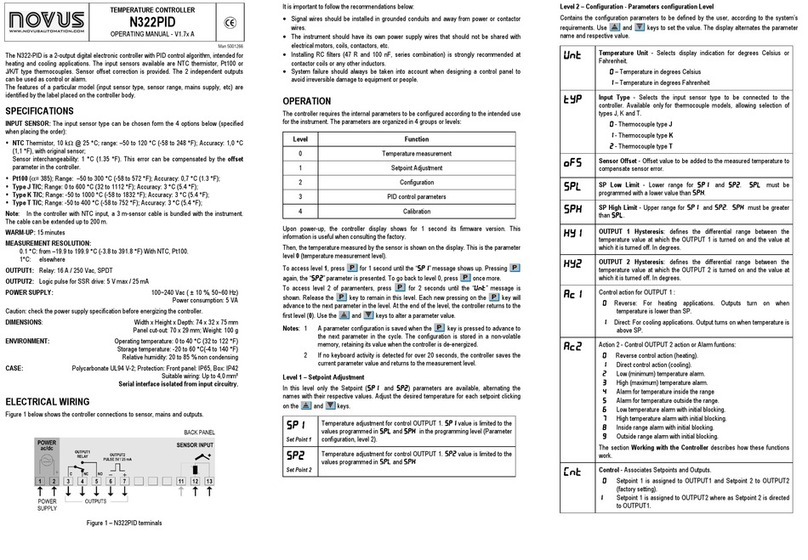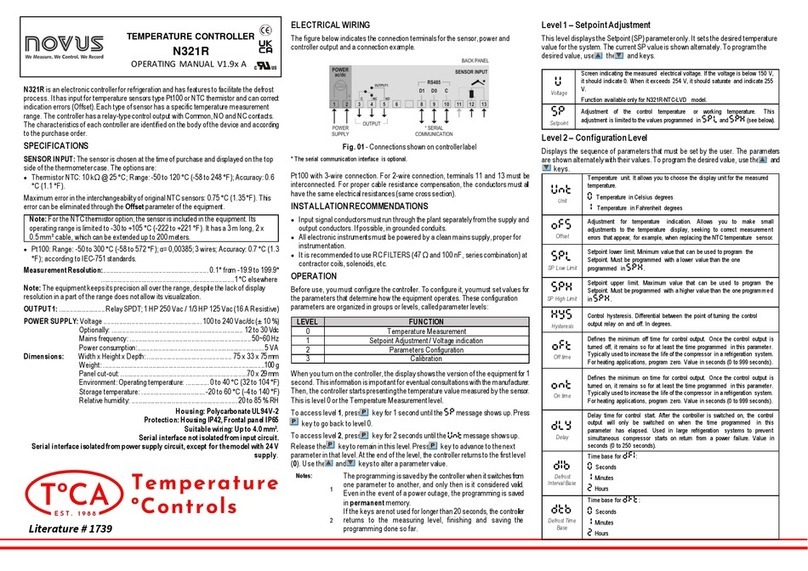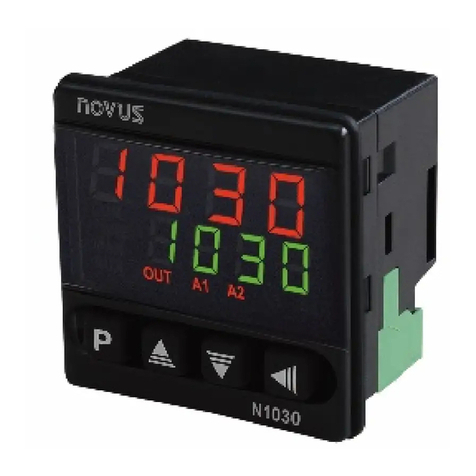
TEMPERATURE CONTROLLER
N322PID
OPERATING MANUAL - V1.7x E
Man 5001266
The N322-PID is a 2-output digital electronic controller with PID control algorithm, intended for
heating and cooling applications. The input sensors available are NTC thermistor, Pt100 or
J/K/T type thermocouples. Sensor offset correction is provided. The 2 independent outputs
can be used as control or alarm.
The features of a particular model (input sensor type, sensor range, mains supply, etc) are
identified by the label placed on the controller body.
SPECIFICATIONS
INPUT SENSOR: The sensor is chosen by the user at the time of purchase and is presented
on the upper side of the equipment box. The options are:
•Thermistor NTC, 10 kΩ@ 25 °C; Range: –50 to 120 °C (–58 to 248 °F); Accuracy: 0.6 °C
(1.1 °F);
Maximum error in the interchangeability of original NTC sensors: 0.75 °C (33.35 °F). This
error can be eliminated through the offset parameter of the equipment.
Note: For the NTC thermistor option, the sensor comes with the equipment. Its operating
range is limited to –30 to +105 °C (–222 to +221 °F). It has cable of 3 m in length, 2 x 0.5
mm², and can be extended up to 200 meters.
•Pt100; Range: –50 to 300 °C (–58 to 572 °F); α= 0,00385; 3 wires;
Accuracy: 0.7 °C (1.3 °F); according to IEC-751 standards;
•Pt1000; Range: –200 to 530 °C (–328 to 986 ºF); α= 0,00385; 3 wires;
Accuracy: 0.7 °C (1.3 °F);
•Thermocouple type J; Range: 0 to 600 °C (32 to 1112 °F); Accuracy: 3 °C (5.4 °F);
•Thermocouple type K; Range –50 to 120 °C (–58 to 248 °F); Accuracy: 3 °C (5.4 °F);
•Thermocouple type T; Range: –50 to 120 °C (–58 to 248 °F); Accuracy: 3 °C (5.4 °F);
Thermocouples according to IEC-584 standards.
WARM-UP: 15 minutes
MEASUREMENT RESOLUTION:
0.1 °C: from –19.9 to 199.9 °C (-3.8 to 391.8 °F) With NTC, Pt100.
1°C: elsewhere
Note: The equipment keeps its precision all over the range, despite the lack of display
resolution in a part of the range does not allow its visualization.
OUTPUT1: Relay: 16 A / 250 Vac, SPDT
OUTPUT2: Logic pulse for SSR drive: 5 V max / 25 mA
POWER SUPPLY: 100~240 Vac (± 10 %, 50~60 Hz)
Power consumption: 5 VA
Caution: check the power supply specification before energizing the controller.
DIMENSIONS: Width x Height x Depth: 74 x 32 x 75 mm
Panel cut-out: 70 x 29 mm; Weight: 100 g
ENVIRONMENT: Operating temperature: 0 to 40 °C (32 to 104 °F)
Storage temperature: -20 to 60 °C (-4 to 140 °F)
Relative humidity: 20 to 85 % no condensing
CASE: Polycarbonate UL94 V-2; Protection: Front panel: IP65, Box: IP42
Suitable wiring: Up to 4.0 mm²
Serial interface isolated from input circuitry.
ELECTRICAL WIRING
Fig. 1 below shows the controller connections to sensor, mains and outputs.
Fig. 1 – N322PID terminals
It is important to follow the recommendations below:
•Signal wires should be installed in grounded conduits and away from power or contactor
wires.
•The instrument should have its own power supply wires that should not be shared with
electrical motors, coils, contactors, etc.
•Installing RC filters (47 R and 100 nF, series combination) is strongly recommended at
contactor coils or any other inductors.
•System failure should always be taken into account when designing a control panel to
avoid irreversible damage to equipment or people.
OPERATION
The controller requires the internal parameters to be configured according to the intended use
for the instrument. The parameters are organized in 4 groups or levels:
Level Function
0 Temperature measurement
1 Setpoint Adjustment
2 Configuration
3 PID control parameters
4 Calibration
Upon power-up, the controller display shows for 1 second its firmware version. This
information is useful when consulting the factory.
Then, the temperature measured by the sensor is shown on the display. This is the parameter
level 0(temperature measurement level).
To access level 1, press for 1 second until the “SP1” message shows up. Pressing
again, the “SP2” parameter is presented. To go back to level 0, press once more.
To access level 2 of paramenters, press for 2 seconds until the “uNT” message is
shown. Release the key to remain in this level. Each new pressing on the key will
advance to the next parameter in the level. At the end of the level, the controller returns to the
first level (0). Use the and keys to alter a parameter value.
Notes: 1 A parameter configuration is saved when the key is pressed to advance to
the next parameter in the cycle. The configuration is stored in a non-volatile
memory, retaining its value when the controller is de-energized.
2If no keyboard activity is detected for over 20 seconds, the controller saves the
current parameter value and returns to the measurement level.
Level 1 – Setpoint Adjustment
In this level only the Setpoint (SP1 and SP2) parameters are available, alternating the
names with their respective values. Adjust the desired temperature for each setpoint clicking
on the and keys.
Set Point 1
Temperature adjustment for control OUTPUT 1. SP1 value is limited to the
values programmed in
and
in the programming level (Parameter
Temperature adjustment for control OUTPUT 1. SP2 value is limited to the
values programmed in
and
Level 2 – Configuration - Parameters configuration Level
Contains the configuration parameters to be defined by the user, according to the system’s
requirements. Use and keys to set the value. The display alternates the parameter
name and respective value.
Temperature Unit -
Selects display indication for degrees Celsius or
Fahrenheit.
– Temperature in degrees Celsius
– Temperature in degrees Fahrenheit
Input Type -
Selects the input sensor type to be connected to the
controller. Available only
for thermocouple models, allowing selection of
types J, K and T.
- Thermocouple type J
- Thermocouple type K
- Thermocouple type T
Sensor Offset - Offset value to be added to the measured temperature to
compensate sensor error.
SP Low Limit - Lower range for
and
.
programmed with a lower value than
.
SP High Limit - Upper range for
and
.
must be greater
than
.
OUTPUT 1 Hysteresis
: defines the differential range between the
temperature value at which the OUTPUT 1 is turned on and the value at
which it is turned off. In degrees.
OUTPUT 2 Hysteresis
: defines the differential range between the
temperature value at which the OUTPUT 2 is turned on and the value at
which it is turned off. In degrees.
Control action for OUTPUT 1 :
Reverse: For heating applicat
ions. Outputs turn on when
temperature is lower than SP.
Direct: For cooling applications. Output turns on when temperature is
above SP.
Action 2 - Control OUTPUT 2 action or Alarm funtions:
Reverse control action (heating).
Direct control action (cooling).
Low (minimum) temperature alarm.
High (maximum) temperature alarm.
Alarm for temperature inside the range
Alarm for temperature outside the range.
Low temperature alarm with initial blocking.
High temperature alarm with initial blocking.
Inside range alarm with initial blocking.
Outside range alarm with initial blocking.
The section Working with the Controller describes how these functions
work.
Control - Associates Setpoints and Outputs.
Setpoint 1 is assigned to OUTPUT1 and Setpoi
(factory setting).
Setpoint 1 is assigned to OUTPUT2 where as Setpoint 2 is directed
to OUTPUT1.






